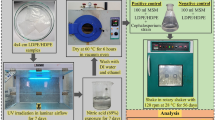Abstract
Polycaprolactone, polyethylene, and blends of polycaprolactone and polyethylene—in which the portion of polycaprolactone was 80 and 10%—were exposed for periods of from 1 to 16 weeks to a consortium of five fungi in a nutrient salt medium containing 0.8 mg/ml potato dextrose. After exposure the samples were cleaned, dried, and analyzed for weight loss, changes in their molecular weight distribution as determined by gel permeation chromatography, molecular changes as seen by Fourier transform infrared spectrometry (FT-IR), and changes in tensile strength. Tensile strength of polycaprolactone began to decrease after 1 week of exposure, even though the molecular weight distribution showed no change. FT-IR spectra indicated a loss of amorphous polycaprolactone from the surface of samples.
Similar content being viewed by others
References
P. Dave, R. A. Gross, C. Brucato, S. Wong, and S. P. McCarthy,Polym. Mater. Sci. Eng. Proc. 62 231 (1990).
W. J. Maddever and G. M. Chapman, inProceedings of Symposium on Degradable Plastics, (Society of the Plastics Industry, Inc., Washington, DC, June 10, 1987), p. 41.
K. C. Ong and W. R. Stanton, inSago-76: Papers of the First International Sago Symposium, (Koonlin Tan, Kuala Lumpur, 1987), p. 240.
J. M. Meyer, M. Greenberger, D. L. Kaplan, R. Gross, and S. McCarthy,Polym. Mater. Sci. Eng. 63 858 (1990).
A.-C. Albertsson and S. Karlsson,Prog. Polym. Sci. 15 177–192 (1990).
M. M. Coleman and J. Zarian,J. Polym. Sci. Polym. Phys. Ed. 17 837 (1979).
C. V. Benedict, J. A. Cameron, and S. J. Huang,J. Appl. Polym. Sci. 28 335–342 (1983).
C. V. Benedict, W. J. Cook, P. Jarrett, J. A. Cameron, S. J. Huang, and J. P. Bell,J. Appl. Polym. Sci. 28 327 (1983).
G. L. Loomis, J. M. Romesser, and W. J. Jewell,Polym. Prepr. 32(2), 127 (1991).
R. T. Graf, J. L. Koenig, and H. Ishida, inSymposium on Fourier Transform Infrared Characterization of Polymers, H. Idhida, ed. (Plenum Press, 1984), p. 385.
W. J. Cook, J. A. Cameron, J. P. Bell, and S. J. Huang,J. Polym. Sci. Polym. Lett. Ed. 19 159 (1981).
R. D. Fields and F. Rodriguez, inProceedings of the Third International Biodegradation Symposium, J. M. Sharpley and A. M. Kaplan, eds. (Applied Science, London, 1976), p. 775.
P. Jarrett, S. J. Huang, J. P. Bell, J. A. Cameron, and C. Benedict,Org. Coat. Appl. Polym. Sci. Proc. 47 45 (1982).
D. Goldberg, J. F. Rocky, R. F. Eaton, S. B. Samuels, K. L. LaCava, and D. G. O'Niel, inProceedings of the International Nonwoven Fabrics Conference (1990).
Author information
Authors and Affiliations
Additional information
Certain commercial products ae identified in order to specify experimental procedures adequately. In no case does such identification imply endorsement by the National Institute of Standards and Technology or that the material is necessarily the best available for the purpose.
Rights and permissions
About this article
Cite this article
Tilstra, L., Johnsonbaugh, D. The biodegradation of blends of polycaprolactone and polyethylene exposed to a defined consortium of fungi. J Environ Polym Degr 1, 257–267 (1993). https://doi.org/10.1007/BF01458292
Issue Date:
DOI: https://doi.org/10.1007/BF01458292




